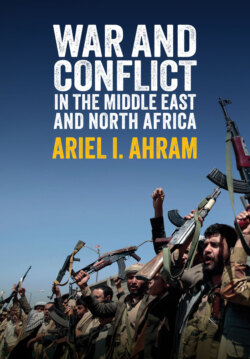Читать книгу War and Conflict in the Middle East and North Africa - Ariel I. Ahram - Страница 15
First Cut: Frequency of War
ОглавлениеThe first cut at an answer about whether MENA is particularly conflict prone comes by comparing the number of conflicts within the region to the rest of the world. Figure 1.1 uses the PRIO/UCDP data to tally every type of conflict that occurred each year between 1945 and 2016. Figure 1.2 calculates the number of wars in MENA annually as a percentage of the global total.
Figure 1.1 Percentage of conflict in MENA countries
Source: Peace Research Institute, Oslo/Uppsala Conflict Data Project, data available at https://www.prio.org/Data/Armed-Conflict/UCDP-PRIO/; Nils Petter Gleditsch et al., “Armed Conflict 1946–2001: A New Dataset,” Journal of Peace Research 39, no. 5 (2002): 615–37.
Figure 1.2 Number of conflicts by year
Source: Peace Research Institute, Oslo/Uppsala Conflict Data Project, data available at https://www.prio.org/Data/Armed-Conflict/UCDP-PRIO/; Gleditsch et al., “Armed Conflict 1946–2001: A New Dataset.”
The results show that while MENA has had decadal spikes in conflict episodes, there have also been years in which the region has been comparatively peaceful. From 1980 until 2000, war in MENA declined both in absolute number and in global proportion. Put another way, the rest of the world experienced more conflicts, but MENA remained stable or declined. Looking at the conflict frequency statistics from 1960 to 2003, PRIO researchers concluded that Asia and Africa were just as conflict prone as MENA or even more so.14
At the same time, it is worth noting that since around 2003 the number of conflicts worldwide has increased dramatically. This increase is driven at least in part by the spike in conflict within MENA itself.
Zooming in on the regional perspective produces an interesting insight into how these wars and conflicts are distributed across the region (Figure 1.3). Certain countries, like Israel and Iraq, have been in continual war over the last seven decades. By contrast, countries like Oman, Tunisia, Kuwait, and Saudi Arabia have seen relatively infrequent and short-lived conflicts (at least until recently). This is not to say that these states were wholly pacific. Rather, it is to suggest that the impact of war-making and its ancillary effects on state and society vary within the region.
Figure 1.3 Years at war for MENA countries, 1945–2017
Source: Peace Research Institute, Oslo/Uppsala Conflict Data Project, data available at https://www.prio.org/Data/Armed-Conflict/UCDP-PRIO/; Gleditsch et al., “Armed Conflict 1946–2001: A New Dataset.”
